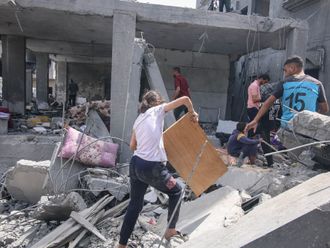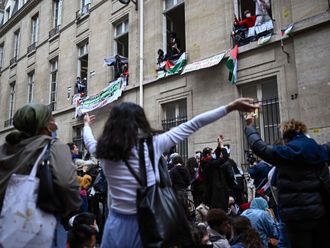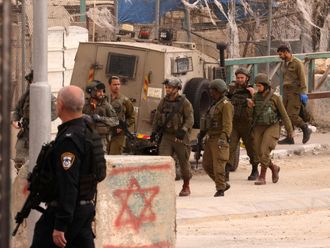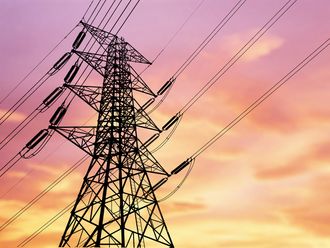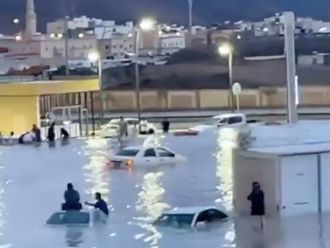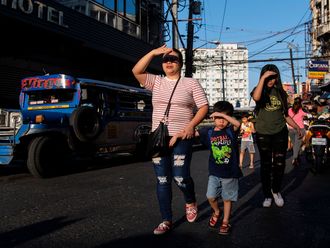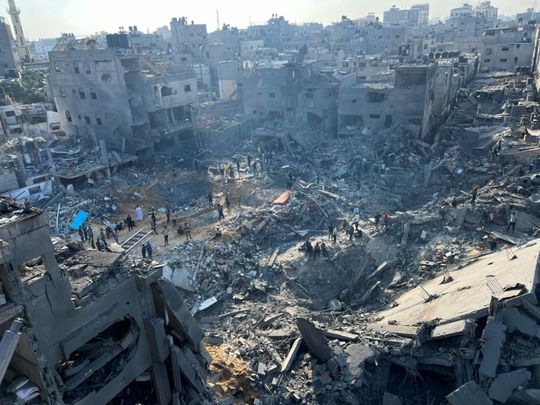
Jerusalem: Kamal Masoud was at home with his wife and five children on Tuesday afternoon in the Jabaliya refugee camp. They were talking about how to survive a bombardment when the Israeli missiles struck.
“The entire area was wiped out,” Masoud told The Washington Post by phone, hours after a series of Israeli strikes devastated his neighborhood in the northern Gaza Strip, flattening several residential buildings and leaving gaping craters in the concrete.
Gaza’s Hamas-run media office said on Thursday that at least 195 Palestinians were killed in the two Israeli attacks on Jabaliya — on Tuesday and Wednesday —, with 120 missing. At least 777 people were wounded, it said in a statement.
Palestinians on Wednesday sifted through rubble in a desperate hunt for trapped victims. “It is a massacre,” said one witness.
Masoud and his family survived. But 30 of his relatives were killed, he said, among them children as young as 2 months old.
“There is no safe place in the invasion,” he said of Israel’s ground operations, which have steadily expanded since Friday — part of what Israeli Prime Minister Benjamin Netanyahu has called the “second phase of the war.”
The strike on Jabaliya offers a glimpse of the destruction wrought across Gaza by Israel’s relentless air war, and the grave dangers facing civilians as Israeli ground forces move deeper into the enclave. At least 8,796 Gazans have been killed since the start of the conflict, according to Gaza’s Health Ministry, and 22,219 wounded.
Scale of the damage spanned size of a football field
By geolocating the edges of the destruction and comparing it with satellite imagery, The Post determined that the scale of the damage spanned roughly 50,000 square feet - nearly the size of a football field - and that the strike toppled or scarred more than a dozen buildings. Debris from the explosion appears to have blackened rooftops in multiple directions.
Israel’s military said the strike - the first of three to hit the densely populated camp in just over 24 hours - targeted and killed a senior Hamas commander, Ibrahim Biari, involved in coordinating the group’s attack on southern Israel on Oct. 7, when militants killed more than 1,400 people and took more than 230 hostages.
Israel Defence Forces spokesman Rear Adm. Daniel Hagari said on Wednesday that other militants were killed alongside Biari, but he did not provide a number. Hamas spokesperson Ali Barakeh told The Post on Wednesday that Biari was “well” and was not at the site of the attack.
“The way [Hamas] builds their infrastructure we have no other way,” Hagari said, claiming the collapse of Hamas tunnels contributed to the high death toll. “We are working according to international law.”
Hagari was unable to provide a count for the number of civilians killed, saying an assessment was still underway.
‘Very complicated battle space’
Pressed by CNN’s Wolf Blitzer on Tuesday night about why the military went ahead with the attack in such a populated area, another IDF spokesman, Lt. Col. Richard Hecht, said it was a “very complicated battle space.”
“But you know that there are a lot of refugees, a lot of innocent civilians - men, women and children - in that refugee camp as well, right?” Blitzer asked Hecht.

“This is the tragedy of war,” Hecht responded.
The dead and wounded from Jabaliya overwhelmed hospitals on the brink of shutting down and rescue teams already struggling with the vastness of the destruction.
Into the evening, residents tried to dig people out from smoldering piles of crumbled cement, rebar and wood. At the hospitals, bloodied bodies, brought in on mattresses and improvised stretchers, filled any available space on the floor. The beds were already full. Rows of corpses wrapped in white shrouds were piled up out front.
Many rescue workers were unable to reach the site because of shortages of fuel and equipment, said Mahmoud Bassal, a spokesperson for the Gaza’s Civil Defense emergency services.
“An entire residential neighborhood was targeted,” Bassal said. “No one who was there came out unscathed. . . . Even if there was anyone affiliated with Hamas, would it make sense for them to be dealt with like this?”
‘Likely caused by Joint Direct Attack Munitions’
Marc Garlasco, a military adviser at the Dutch organisation PAX for Peace and a former UN war crimes investigator, said craters he analyzed in aftermath images of the site were likely caused by Joint Direct Attack Munitions, or JDAM bombs, using a delayed fuse.
A comparison of satellite imagery provided to The Post by Maxar Technologies, combined with photo and video evidence, reveals at least five distinct impact sites where bombs hit. At least one crater was about 40 feet in diameter, according to The Post’s measurements, which Garlasco said suggests one of the munitions was about 2,000 pounds.
“When a 2,000-pound bomb hits the ground, the earth turns to liquid,” Garlasco wrote in a message to The Post. “It’s like an earthquake.”
Video and photos verified by The Post show scenes resembling the aftermath of a natural disaster. Multiple buildings had collapsed in on themselves. People scrambled up hills of rubble and down into the yawning craters, searching for survivors.
Hospitals not always a refuge
Israel has repeatedly warned Gazans to leave the north and head south to protect themselves as ground operations expand. But Palestinians in the north have told The Post they lack the means to relocate, and have nowhere to stay in the south. Some of those who have evacuated have been killed while fleeing, or have died in Israeli strikes on the south - in what is meant to be a safe zone.
Hospitals are not always a refuge either. Over the weekend, strikes near Gaza’s Indonesian hospital - which treated many of the victims of Tuesday’s attack - caused “severe damage,” according to a spokesman for the Gaza Health Ministry. In a video posted on social media and geolocated by The Post, dust clouds are seen outside the hospital; people nearby are wiping their eyes and covering their mouths.
On Friday, as Israeli troops made their largest incursion yet into Gaza, Israel cut nearly all internet and phone lines in the enclave for more than 30 hours. Communications networks were partially restored by Israel on Sunday under U.S. pressure, but internet and phone service remains intermittent and unstable.
In the hours after Tuesday’s strike, families desperately tried to reach relatives in Jabaliya - unsure if calls were not going through because phone batteries were dead, or their loved ones were.
Marwan Sultan, the director of the Indonesian hospital, told The Post that his staff received at least 110 people who were killed and more than 300 who were wounded after the first attack.
Later that night, another Israeli strike hit a different part of the camp, killing at least 20 people from the same family, according to Sultan.
On Wednesday, a third Israeli strike hit the Fallujah neighbourhood of Jabaliya, killing dozens, Sultan said, adding that he expected the casualty count to rise.
“We are still receiving more casualties, including amputees and [people with] internal bleeding in the brain,” he said in a phone interview. “Unfortunately, after a few hours we will have to stop working in the operating rooms,” he said, because of fuel shortages. There are still “dozens under the rubble,” he added.
Wednesday’s strike - which the IDF said targeted a Hamas “command and control complex” —occurred during another hours-long, near-total communication blackout.
“We had to use loudspeakers to summon our crews and urge them to go to the targeting site to start saving people’s lives,” Sultan said.
Hussam Abu Safiya, director of pediatrics at the Kamal Adwan Hospital, said his staff has received dozens of dead bodies and hundreds of wounded people since Tuesday afternoon, with each strike adding to the carnage.
Sometimes, “we are unable to deal with injuries,” he said, because the smell of death is “suffocating.”



